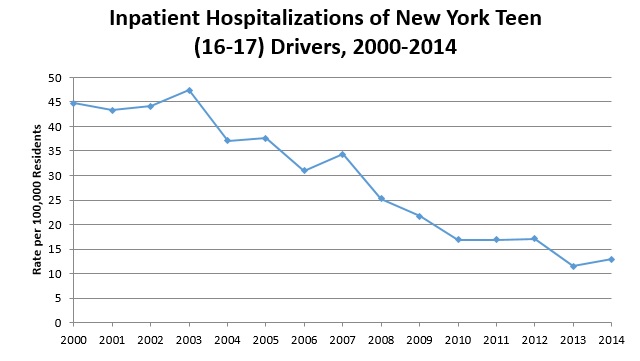Get the Facts About Sixteen and Seventeen Year-Old Drivers in New York State*

How big is the problem?
- Motor vehicle crashes are a leading cause of unintentional deaths for teens (16-17) in New York State.
- Every day, approximately 10 people are killed or seen in hospitals due to car crashes caused by a teen driver.
What is the cost?
In 2014, injuries caused by teen drivers resulted in almost $23 million in hospital charges in New York State. The average hospital stay for a teen driver injured in a crash lasts over five days and results in more than $53,000 in charges.
Who is most at risk?
- Newly licensed teens are at the highest risk of a car crash during the first months of driving unsupervised.
- Male teen drivers are more likely to be involved, seriously injured, or killed in a car crash than their female counterparts.
- Teen passengers (16-20 years old) are more likely to be seriously injured or killed in a car crash when riding with a teen driver.
- Child passengers (7-15 years) are twice as likely to be seriously injuried or killed in a car crash when riding with a teen driver.
What factors put teen drivers at risk?
| New York State, 2014 Incapacitating & Fatal Injuries |
||
|---|---|---|
| Crash Contributing Factors | Driver's Age | |
| 16-17 yrs | 25-49 yrs | |
| Unsafe Speed | 21% | 10% |
| Driver Inexperience | 8% | 0.5% |
| Failure to Yield Right of Way | 6% | 3% |
| Driver Distraction* | 4% | 5% |
| Alcohol Involvement | 1% | 7% |
| * Driver Distraction includes the contributing factors of Driver Inattention/Distraction, Passenger Distraction, Cell Phone (hand held), Cell Phone (hands-free), Other Electronic Device and Outside Car Distraction. | ||
- Driver Inexperience. Teens are more likely to underestimate dangerous situations and less likely to recognize hazardous situations when driving.
- Drowsy Driving. Teen drivers are more likely to drive drowsy, or fall asleep behind the wheel when compared to more experienced drivers. Male teen drivers are twice as likely than female teen drivers to drive drowsy, or fall asleep behind the wheel.
- Safety Belt Use. Teen drivers and their passengers are over four times more likely to be diagnosed with a traumatic brain injury, and more likely to be ejected from the vehicle in crash, if they are not properly restrained.
- Impaired Driving.Teen drivers involved in impaired driving crashes are five times more likely to suffer from a fatal or severe injury than those who were not. Teen drivers involved in impaired driving crashes are four times more likely not to buckle up.
- Driving Distractions. Every day, four teen drivers are involved in crashes where distraction was a contributing factor. Teens driving with three or more teen passengers are more likely to be killed or seriously injured in a crash. Female teen drivers are slightly more likely to be involved in distraction-related crashes than their male counterparts.
- Unsafe Speed. Every day, three teen drivers are involved in crashes where unsafe speed is a contributing factor. Male teen drivers are more likely to be involved in crashes as a result of unsafe speed than their female counterparts..
What are the leading causes of teen car crashes?
- Unsafe speed is the leading contributing factor of crashes that result in incapacitating and fatal injuries for teens, followed by driver inexperience, failure to yield, and driver distraction.
- Teen drivers are at fault in 78% of crashes resulting in incapacitating and fatal injuries. Their more experienced counterparts, drivers aged 25-49 years old, are at fault 58% of the time.

How can deaths and injuries resulting from crashes involving teen drivers be prevented?
- Graduated Drivers Licensing (GDL) Laws. The GDL helps new drivers gain experience under low-risk conditions by granting driving privileges in stages. For more information about New York State GDL provisions, visit the Department of Motor Vehicles website.
- The yearly rate of motor vehicle crash related hospitalizations for teen drivers ages 16-17 decreased over 73% between 2003, the year the New York State GDL was implemented, and 2014.
- In 2010, changes to the New York State GDL limited the number of passengers in a vehicle operated by a junior license holder, as well as increasing the length of time a permit must be held and number of supervised driving hours needed before scheduling a road test.
- Parental management of teen driving. When parents know their state's GDL laws, they can help enforce the laws and, in effect, help keep their teen drivers safe. A parent/teen driving agreement is one tool to help parents set and enforce driving rules during the first year of unsupervised driving. A sample contract is available on the Department of Motor Vehicles website.
Where can I find more information and resources?
- Younger Driver Safety
- New York State Department of Motor Vehicles
- Centers for Disease Control and Prevention
- Children's Hospital of Philadelphia "Teen Driver Source"
For more information, please contact the New York State Department of Health, Bureau of Occupational Health and Injury Prevention at injury@health.ny.gov.
* Unless otherwise specified, "teen driver" refers to 16 and 17 year-old drivers.